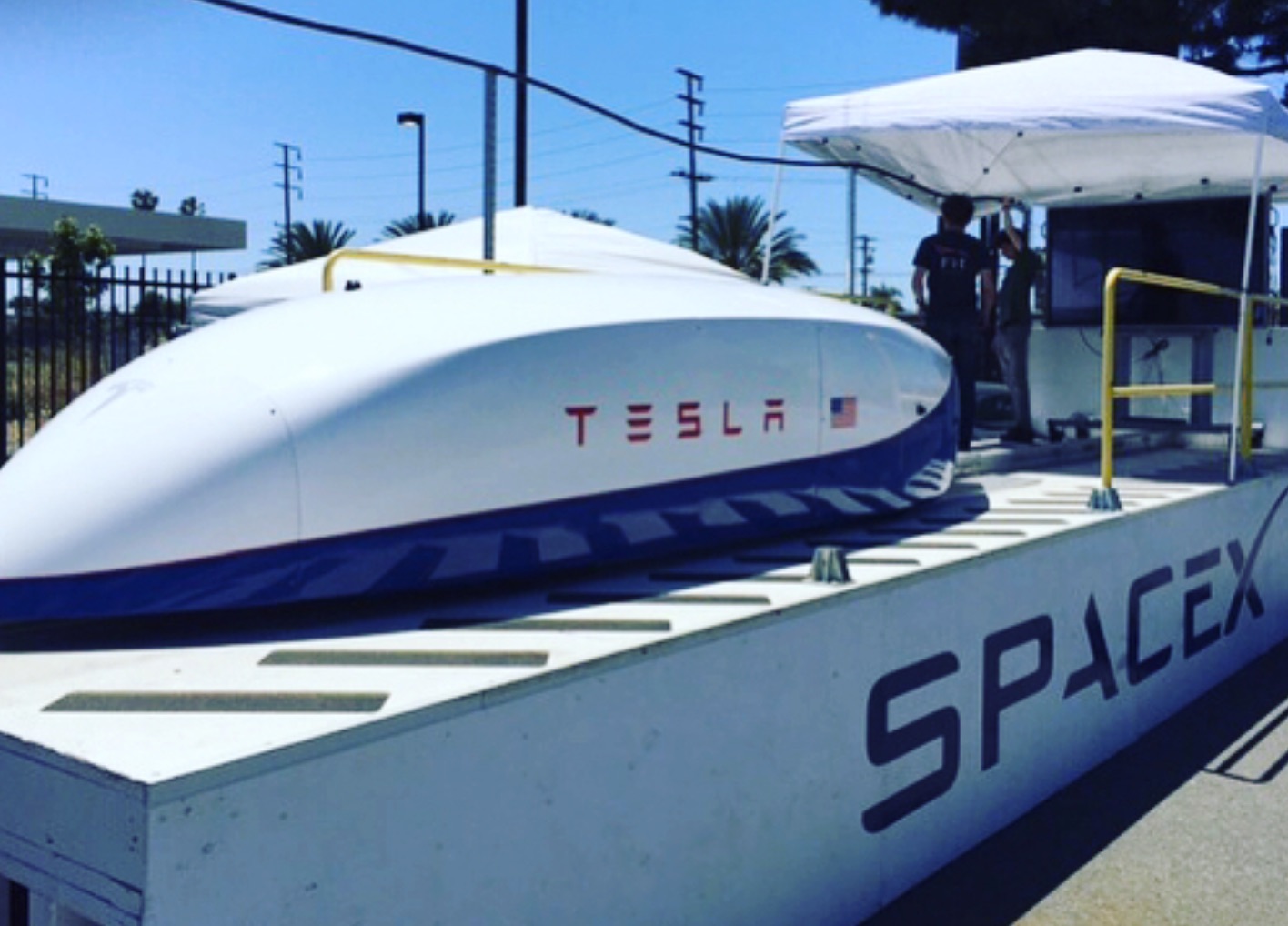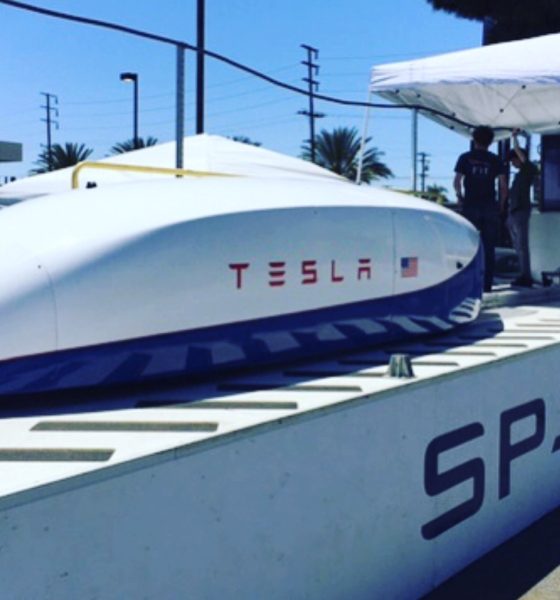

News
SpaceX/Tesla’s Hyperloop pod will attempt to reach 1/2 speed of sound
Elon Musk recently announced that a speed test for the upgraded SpaceX Hyperloop pod would be conducted soon. This time around, Musk said that the goal would be to accelerate to half the speed of sound and stop within ~1.2 km.
Musk’s updates came late Saturday on Twitter. Expanding on a tweet he posted last August about the SpaceX Hyperloop pusher pod, Musk candidly stated that the new goal for the upcoming speed test would be “kinda nutty.” Accelerating from a standstill to a blazing 383.7 mph (half the speed of sound) in around 1.2 km, after all, is a pretty challenging endeavor.
Despite the risks, however, Musk lightly joked that the upgraded Hyperloop pod’s speed test would be exciting nonetheless.
“This is kinda nutty for such a short distance, so could easily end up being shredded metal, but exciting either way,” Musk tweeted.
This is kinda nutty for such a short distance, so could easily end up being shredded metal, but exciting either way
— Elon Musk (@elonmusk) April 8, 2018
During a post on Instagram last year, Musk said that the SpaceX team decided to see how fast the pusher pod could go on its own, considering that the machine had mostly been used to push some of the pods of the competing student teams. According to Musk, the Hyperloop pusher pod was able to hit 220 mph before things started heating up. Thus, if the machine could dash to half the speed of sound this time around, it would be a notable accomplishment.
https://www.instagram.com/p/BYckipugds5/
The upcoming speed test of the upgraded SpaceX Hyperloop pusher pod comes as the 2018 Hyperloop Pod Competition draws nearer. The 2018 competition, which is set to take place on July 22, 2018, will see teams of students from across the globe compete in a contest to see which could come up with the best design for a Hyperloop pod. According to SpaceX’s page for the competition, teams this year will be focusing on one particular metric — maximum speed.
Over the past couple of years, WARR Hyperloop, a team from the Technical University of Munich, has managed to win the competition. Last year, the students built a lightweight pod that was propelled with a 50 kW electric motor and connected to polyurethane wheels. During the contest, WARR Hyperloop’s 190-lb machine was able to hit 202 mph, blowing away its two toughest competitors — Paradigm Hyperloop and SwissLoop.
WARR Hyperloop is preparing to defend their title for this year’s competition. According to the group’s official website, the WARR Hyperloop team for 2018 will be comprised of 45 members from 16 different countries. A brand new pod is also under development.
As we noted in a previous report, Elon Musk’s Hyperloop idea has inspired Dubai to commit to the project. Just recently, a full-scale prototype model of a Hyperloop One passenger pod was unveiled in Dubai’s City Walk Mall. The 8.7-meter-long, 3.3-meter-diameter pod featured various plush amenities, including BMW-designed seats, generous legroom, and a lighting scheme that would not look out of place in a sci-fi movie.
Dubai’s Hyperloop system is expected to start operations as early as 2020, with the ultra-high-speed transport system connecting key cities in the region, such as Abu Dhabi and Dubai.
Watch a recap of the 2017 Hyperloop Pod Competition below.

Elon Musk
Elon Musk’s X will start using a Tesla-like software update strategy
The initiative seems designed to accelerate updates to the social media platform, while maintaining maximum transparency.

Elon Musk’s social media platform X will adopt a Tesla-esque approach to software updates for its algorithm.
The initiative seems designed to accelerate updates to the social media platform, while maintaining maximum transparency.
X’s updates to its updates
As per Musk in a post on X, the social media company will be making a new algorithm to determine what organic and advertising posts are recommended to users. These updates would then be repeated every four weeks.
“We will make the new 𝕏 algorithm, including all code used to determine what organic and advertising posts are recommended to users, open source in 7 days. This will be repeated every 4 weeks, with comprehensive developer notes, to help you understand what changed,” Musk wrote in his post.
The initiative somewhat mirrors Tesla’s over-the-air update model, where vehicle software is regularly refined and pushed to users with detailed release notes. This should allow users to better understand the details of X’s every update and foster a healthy feedback loop for the social media platform.
xAI and X
X, formerly Twitter, has been acquired by Elon Musk’s artificial intelligence startup, xAI last year. Since then, xAI has seen a rapid rise in valuation. Following the company’s the company’s upsized $20 billion Series E funding round, estimates now suggest that xAI is worth tens about $230 to $235 billion. That’s several times larger than Tesla when Elon Musk received his controversial 2018 CEO Performance Award.
As per xAI, the Series E funding round attracted a diverse group of investors, including Valor Equity Partners, Stepstone Group, Fidelity Management & Research Company, Qatar Investment Authority, MGX, and Baron Capital Group, among others. Strategic partners NVIDIA and Cisco Investments also continued support for building the world’s largest GPU clusters.
News
Tesla FSD Supervised wins MotorTrend’s Best Driver Assistance Award
The decision marks a notable reversal for the publication from prior years, with judges citing major real-world improvements that pushed Tesla’s latest FSD software ahead of every competing ADAS system.

Tesla’s Full Self-Driving (Supervised) system has been named the best driver-assistance technology on the market, earning top honors at the 2026 MotorTrend Best Tech Awards.
The decision marks a notable reversal for the publication from prior years, with judges citing major real-world improvements that pushed Tesla’s latest FSD software ahead of every competing ADAS system. And it wasn’t even close.
MotorTrend reverses course
MotorTrend awarded Tesla FSD (Supervised) its 2026 Best Tech Driver Assistance title after extensive testing of the latest v14 software. The publication acknowledged that it had previously criticized earlier versions of FSD for erratic behavior and near-miss incidents, ultimately favoring rivals such as GM’s Super Cruise in earlier evaluations.
According to MotorTrend, the newest iteration of FSD resolved many of those shortcomings. Testers said v14 showed far smoother behavior in complex urban scenarios, including unprotected left turns, traffic circles, emergency vehicles, and dense city streets. While the system still requires constant driver supervision, judges concluded that no other advanced driver-assistance system currently matches its breadth of capability.
Unlike rival systems that rely on combinations of cameras, radar, lidar, and mapped highways, Tesla’s FSD operates using a camera-only approach and is capable of driving on city streets, rural roads, and freeways. MotorTrend stated that pure utility, the ability to handle nearly all road types, ultimately separated FSD from competitors like Ford BlueCruise, GM Super Cruise, and BMW’s Highway Assistant.
High cost and high capability
MotorTrend also addressed FSD’s pricing, which remains significantly higher than rival systems. Tesla currently charges $8,000 for a one-time purchase or $99 per month for a subscription, compared with far lower upfront and subscription costs from other automakers. The publication noted that the premium is justified given FSD’s unmatched scope and continuous software evolution.
Safety remained a central focus of the evaluation. While testers reported collision-free operation over thousands of miles, they noted ongoing concerns around FSD’s configurable driving modes, including options that allow aggressive driving and speeds beyond posted limits. MotorTrend emphasized that, like all Level 2 systems, FSD still depends on a fully attentive human driver at all times.
Despite those caveats, the publication concluded that Tesla’s rapid software progress fundamentally reshaped the competitive landscape. For drivers seeking the most capable hands-on driver-assistance system available today, MotorTrend concluded Tesla FSD (Supervised) now stands alone at the top.
News
Elon Musk’s Grokipedia surges to 5.6M articles, almost 79% of English Wikipedia
The explosive growth marks a major milestone for the AI-powered online encyclopedia, which was launched by Elon Musk’s xAI just months ago.

Elon Musk’s Grokipedia has grown to an impressive 5,615,201 articles as of today, closing in on 79% of the English Wikipedia’s current total of 7,119,376 articles.
The explosive growth marks a major milestone for the AI-powered online encyclopedia, which was launched by Elon Musk’s xAI just months ago. Needless to say, it would only be a matter of time before Grokipedia exceeds English Wikipedia in sheer volume.
Grokipedia’s rapid growth
xAI’s vision for Grokipedia emphasizes neutrality, while Grok’s reasoning capabilities allow for fast drafting and fact-checking. When Elon Musk announced the initiative in late September 2025, he noted that Grokipedia would be an improvement to Wikipedia because it would be designed to avoid bias.
At the time, Musk noted that Grokipedia “is a necessary step towards the xAI goal of understanding the Universe.”
Grokipedia was launched in late October, and while xAI was careful to list it only as Version 0.1 at the time, the online encyclopedia immediately earned praise. Wikipedia co-founder Larry Sanger highlighted the project’s innovative approach, noting how it leverages AI to fill knowledge gaps and enable rapid updates. Netizens also observed how Grokipedia tends to present articles in a more objective manner compared to Wikipedia, which is edited by humans.
Elon Musk’s ambitious plans
With 5,615,201 total articles, Grokipedia has now grown to almost 79% of English Wikipedia’s article base. This is incredibly quick, though Grokipedia remains text-only for now. xAI, for its part, has now updated the online encyclopedia’s iteration to v0.2.
Elon Musk has shared bold ideas for Grokipedia, including sending a record of the entire knowledge base to space as part of xAI’s mission to preserve and expand human understanding. At some point, Musk stated that Grokipedia will be renamed to Encyclopedia Galactica, and it will be sent to the cosmos.
“When Grokipedia is good enough (long way to go), we will change the name to Encyclopedia Galactica. It will be an open source distillation of all knowledge, including audio, images and video. Join xAI to help build the sci-fi version of the Library of Alexandria!” Musk wrote, adding in a later post that “Copies will be etched in stone and sent to the Moon, Mars and beyond. This time, it will not be lost.”








